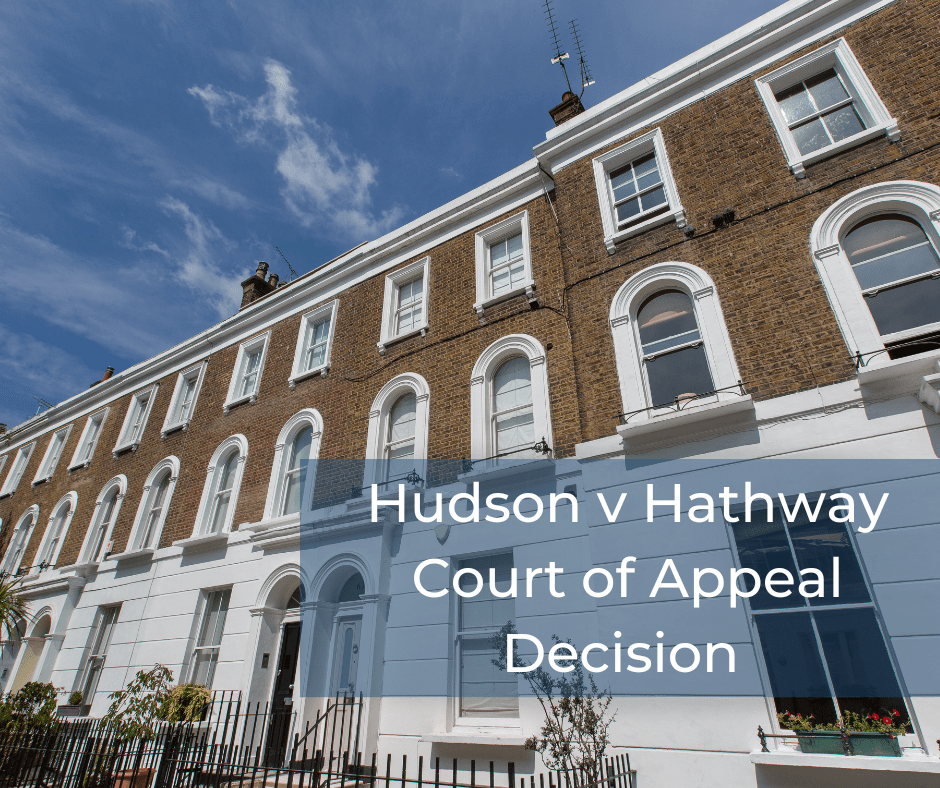
Hudson v Hathway – Court of Appeal Confirms Detrimental Reliance to Establish Common Intention Constructive Trust
In the latest round of litigation, (the second appeal) between Hudson and Hathway, the Court of Appeal confirmed that a party claiming a subsequent increase in their equitable share due to a post-acquisition changed common intention must show detrimental reliance on the changed common intention.
The judgment is significant to cohabitating couples who jointly own their home.
The Court of Appeal considered the following:
• Must a party claiming a subsequent increase in her equitable share necessarily have acted to her detriment? Or does a common intention alone suffice to alter the beneficial shares?
• If the former, was HHJ Ralton right to decide that the requirement of detriment was met?
The Court of Appeal rejected the EWHC’s judgment (first appeal) that detrimental reliance was no longer required in such a claim and agreed with HHJ Ralton (trial judge) that the detriment requirement was met.
Of great significance is the new legal point raised by the Court of Appeal itself, namely whether section 53 (1)(c) of the Law of Property Act 1925 (LPA 1925) had been satisfied in respect of the 2013 emails between the parties when discussing their financial arrangements.
Background
The parties to the litigation were not married but jointly owned their home, Picnic House. There was no declaration of trust. They paid the mortgage from a joint account into which their salaries were paid. It was presumed they held the property in equal shares.
Two years after purchasing the house and 19 years after the start of their relationship, the couple split up. Ms Hathway remained in the house with their two sons. They continued to pay the mortgage from the same account. Mr Hudson’s contribution was far more than Ms Hathway’s.
After their separation, they discussed the division of their property via email. In emails during 2013, they agreed that Mr Hudson would keep his pension and shares. Ms Hathway would get, amongst other things, the equity from the house. In 2015, Mr Hudson stopped paying the mortgage.
In 2019, Mr Hudson sought the sale of the house and claimed that the equity should be divided equally between them. Ms Hathway agreed to sell the house but claimed sole ownership of the equity based on a common intention constructive trust. She claimed that she relied on it to her detriment.
At the first instance hearing, HHJ Ralton held that Ms Hathway was entitled to the entire proceeds of the sale of the house. The judge held there must be a detrimental reliance or change of position in a joint name case. The degree of detrimental reliance is case specific, and although Ms Hathway’s claim may have been a “weak claim”, it was a claim.
The trial judge found that Ms Hathway acted to her detriment when she gave up her perceived claim to Mr Hudson’s shares and pension and declared Ms Hathway, the sole owner of the equity in Picnic House.
He further found that the parties clearly reached an agreement via emails. They agreed the house would be sold, and there was a clear common intention that Ms Hathway would be entitled to the entire equity.
First Appeal
Mr Hudson appealed and argued that detrimental conduct is necessary to alter beneficial shares and to make the agreement enforceable.
He submitted that the first instance judge was wrong to find Ms Hathway acted to her detriment. He argued Ms Hathway was never entitled to his pension and shares; since they were not married, matrimonial remedies didn’t apply to the case. Without detriment, no constructive trust was created.
Mr Justice Kerr held the agreement between Mr Hudson and Ms Hathway was sufficient to establish a common intention, and the common intention was sufficient to alter beneficial shares. It is unnecessary to show detrimental reliance or a change of position in a domestic consumer context where a property has been purchased in joint names with no declaration of trust. He found the trial judge was entitled to find sufficient detriment.
The judgment raised some questions about the decision’s impact on cohabitation claims. Fortunately, the Court of Appeal clarified and raised another legal point for consideration.
Second Appeal
Mr Hudson appealed the judgment of Mr Justice Kerr. The Court of Appeal dismissed the appeal but for different reasons than those of Mr Justice Kerr.
Is detrimental reliance necessary?
The court held that a party claiming a subsequent increase in their equitable share due to a post-acquisition changed common intention must show detrimental reliance on the changed common intention.
Lord Justice Lewison rejected Kerr J’s judgement that detrimental reliance was no longer required. He remarked, “the overwhelming weight of authority before and after Stack v Dowden and Jones v Kernott is to the contrary. Moreover, to hold that an oral agreement, disposition or declaration of trust was binding without more would directly contradict two statutory provisions. Equity cannot repeal the statute”.
He referred to Guess v Guess reaffirming the critical importance of detrimental reliance to the intervention of equity.
In Guess v Guess, Lord Briggs held: … “detriment is relevant to both the arising of the equity and to the remedy. Without reliant detriment, there is simply no equity at all. This reflects the notion that it is the reliant detriment which makes it unconscionable for the promisor to go back on his promise.”
Lewison LJ concluded: “I adhere, therefore, to the view that I expressed in Curran v Collins, namely that in the absence of signed writing, detrimental reliance remains a key component in establishing a common intention constructive trust.
Was detrimental reliance established?
HHJ Ralton held the fact that Ms Hathway did not make any claims against Mr Hudson’s pension or shares was sufficient detrimental reliance. Kerr J did not consider the question of detriment afresh.
Lord Justice Lewison held that in the absence of a transcript of the evidence at trial, there is no ground to interfere with the judge’s finding of fact. He held the trial judge correctly decided on the facts that the requirement of detrimental reliance was met.
Section 53 (1)(c) of the Law of Property Act 1925
Lewison LJ pointed out that this case concerns property rights in land. The creation and transfer of property rights in land must, as a general rule, comply with statutory formalities. The most important of such formalities are those laid down by section 2 of the Law of Property (Miscellaneous Provisions) Act 1989 (contracts for the sale or creation of interests in land must be in signed writing) and section 53 (1) of the Law of Property Act 1925.
Whether the emails satisfied sec 53(1) of the LPA 1925 was not argued up until this stage. After being prompted by the Court of Appeal, Ms Hathway amended her notice to take the point that the relevant emails complied with statutory formalities.
Did the emails comply with sec 53(1)?
Section 53(1) provides:
“(a) no interest in land can be created or disposed of except by writing signed by the person creating or conveying the same, or by his agent thereunto lawfully authorised in writing, or by will, or by operation of law;…
(c) a disposition of an equitable interest or trust subsisting at the time of the disposition, must be in writing signed by the person disposing of the same, or by his agent thereunto lawfully authorised in writing or by will.”
It was common ground that the parties initially held Picnic House as joint tenants in law and equity. Section 36 (2) expressly preserves the right of one joint tenant to release his interest to the other joint tenant. For a release, there is no need for any particular form of words.
Lewison LJ held that the relevant emails are sufficient in form to amount to a release of his equitable interest in the property. They showed a “clear intention to divest himself of that interest immediately, rather than a promise to do so in the future”. He found that the relevant emails amounted to a “disposition” for the purposes of sec 53.
There was no dispute that the emails were “writing”. The question was whether they were “signed” as intended by the law.
Lewison LJ referred to several authorities and concluded that there is a substantial body of authority to the effect that deliberately subscribing one’s name to an email amounts to a signature. The law recognises technological developments and would not necessarily expect “wet ink” signatures anymore.
The relevant emails were all subscribed “Lee” (Mr Hudson’s name).
The court held the emails were all “signed” as required by sec 53 (1) (a) and (c).
There was thus a disposition, and it complied with statutory requirements. Therefore, the emails released Mr Hudson’s beneficial interest in Picnic House to Ms Hathway.
Strictly speaking, that could have concluded the appeal. Ms Hathway did not need to rely on common intention constructive trust.
The court, however, continued to decide the point of principle since permission for the second appeal was specifically granted to determine whether a constructive trust can arise simply as a matter of common intention without the need to show any detrimental reliance on that intention.
Comments
It seems then that the EWCA cleared the muddied waters around detrimental reliance and highlighted another extremely important aspect to bear in mind when communicating by email. Parties must exercise caution when drafting emails relating to the disposal of property. It is clearly important that if you are in doubt, seek assistance from our Family & Matrimonial team.
The Court of Appeal judgement can be seen at Hudson v Hathway [2022] EWCA Civ 1648







